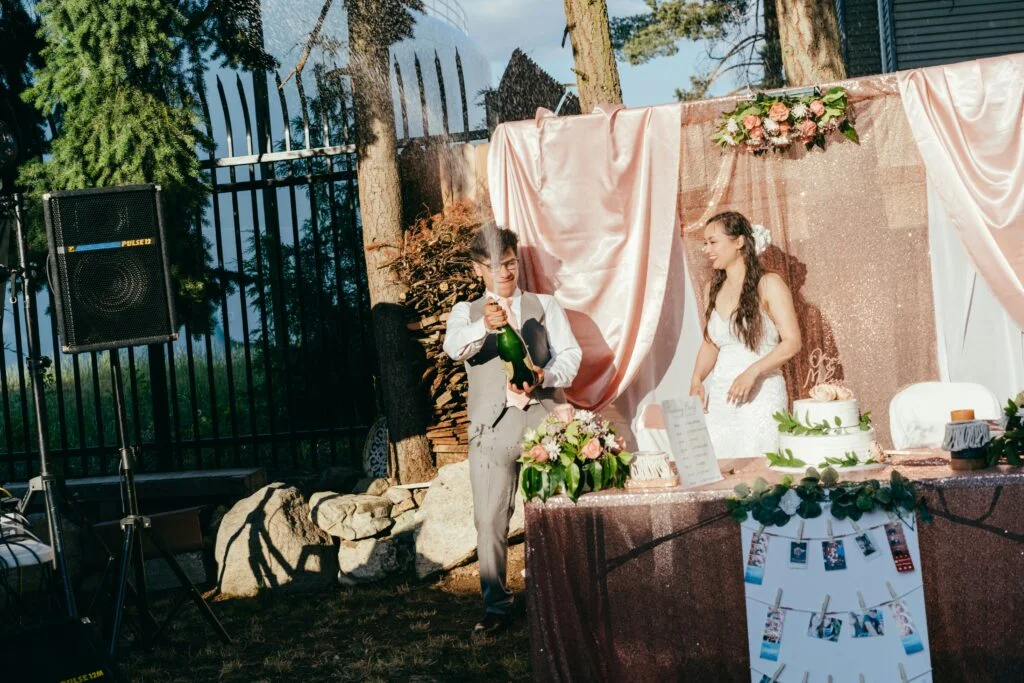The Rise of Divorce Celebrations
Divorce celebrations, often referred to as divorce parties, have progressively gained traction in contemporary society as a means to acknowledge the end of a marriage while simultaneously embracing the freedom that follows. Traditionally viewed through a lens of stigma and sadness, divorce is now increasingly seen as an opportunity for personal reinvention and liberation. This cultural shift may be attributed, in part, to the dynamic influence of social media platforms. These platforms enable individuals to share their experiences and perspectives, contributing to a broader acceptance and normalization of divorce celebrations.
As individuals post about their divorce parties, depict their journeys toward self-discovery, and express their excitement for new beginnings, a narrative emerges that resists the often-negative connotations associated with divorce. This transformation in cultural perception allows individuals to reclaim their identities, which may have been overshadowed during the course of their marriages. By celebrating the occasion, participants affirm their newfound autonomy and foster a sense of empowerment, enabling them to look forward with optimism and hope.
Moreover, divorce parties can serve as communal events, providing support from friends and family who gather to reinforce the message that separation does not equate to isolation. Attendees often share stories, laughter, and affirmations of strength, creating a collective experience that can aid in emotional healing. Through these celebrations, individuals are not only able to process their feelings but also redefine their narratives in a more positive light, contrasting sharply with the narrative of loss traditionally associated with divorce. Consequently, this trend reflects a significant shift in how society views divorce, transforming it from an overwhelmingly negative experience into one that can be celebrated, acknowledged, and used as a platform for new beginnings.
Inside the Party
The divorce party unfolds in a vibrant atmosphere, designed to celebrate the newfound freedom of its host. The theme, aptly named “Unveiling New Chapters,” encompasses a blend of playful decor and meaningful symbolism. Banners emblazoned with phrases like “Goodbye Ties, Hello Freedom!” hang alongside playful caricatures of famous couples juxtaposed with humorous phrases. Each element emphasizes the transition from married life to independence, creating a lighthearted yet poignant ambiance.
The centerpiece of the celebration is, undoubtedly, the elaborate cake. Crafted in the shape of a broken wedding ring, this confectionary masterpiece offers layers of decadent chocolate and vanilla, delightfully contrasted with a bold raspberry filling. Ironic and humorous decorations adorn the cake, such as tiny figurines of a bride and groom breaking apart, evoking laughter and camaraderie among guests. This cake not only serves as a visual statement but also symbolizes the bittersweet end of a chapter, while leaving ample room for delicious treats that highlight the spirit of moving forward.
Another unique aspect of the divorce party is the concept of ‘un-vows.’ Inspired by traditional wedding vows, guests are invited to share humorous or heartfelt declarations about their transition to singlehood. These un-vows provide an opportunity to reflect on past experiences while celebrating the new beginnings ahead. Reactions from the audience vary from heartfelt applause to laughter, as each shared sentiment resonates in a room filled with supportive friends, offering a sense of unity amidst the significant life change.
The interactive atmosphere fosters connection among attendees; guests engage in games that encourage them to reminisce about the past while looking optimistically toward the future. The blend of laughter, decor, and heartfelt celebration encapsulates the freedom associated with the end of a marriage, highlighting that life, while taking unexpected turns, can still be full of joy and friendship.
The Theme of Rebirth
The theme of rebirth in a divorce party serves as a powerful representation of transformation and the beginning of a new chapter in life. This celebration is not merely about the dissolution of a marriage; it encapsulates the spirit of freedom, self-discovery, and renewal. The host can create an atmosphere that invites guests to reflect on their own personal journeys while acknowledging the transition that the host is undergoing. To enhance this theme, elements such as attire, decorations, and activities should align harmoniously, embodying the essence of rebirth.
Attire plays a crucial role in symbolizing the fresh start that comes with divorce. Guests might opt for vibrant colors or motifs that evoke the energy of spring, suggesting growth and new opportunities. Imagine a palette filled with lively shades of yellow, green, or blue, reflecting optimism and joy. This conscious choice in clothing helps in setting the tone of the event and encourages participants to embrace their own personal evolution.
Decorations can serve as a physical manifestation of rebirth, transforming the event space into a sanctuary of hope and renewal. Elements such as blooming flowers, butterflies, and imagery depicting nature can signify transformation. These symbols not only beautify the surroundings, but they also evoke the notion of shedding the old in favor of a brighter future. Incorporating meaningful quotes and art that celebrate independence and new beginnings can further amplify this theme.
Activities curated for the occasion can provide significant opportunities for introspection and connection. Engaging in collaborative projects, such as creating vision boards or writing letters of encouragement to one another, can reinforce the collective spirit of rebirth. This also allows guests to recognize and share their aspirations, thus illustrating that while one chapter may have closed, many exciting possibilities lie ahead. Supporting the host’s journey while establishing a sense of camaraderie amongst attendees enhances the experience, ensuring that everyone leaves not just celebrating an end, but animated by the promise of new beginnings.
Guests’ Reactions and Experiences
As the divorce party commenced, attendees’ responses varied, reflecting the complex emotions often associated with the end of a significant relationship. Many of the guests, including close friends and family, expressed feelings of joy and relief. They viewed the celebration as not only a farewell to an unhappy union but also as an opportunity to embrace new beginnings for the host. Anecdotes shared throughout the evening illuminated this sentiment. For instance, one guest recalled the moment the host announced the divorce; it was met with tears of sadness followed by heartfelt support from those surrounding her. This transition strengthened their bond, creating a unified front focused on positivity and growth.
Among the attendees, some shared their own experiences with relationships and breakups, which sparked candid conversations. These discussions enabled the group to reflect on their journeys, reinforcing how healing often involves vulnerability and connection. Another guest noted how her support during her friend’s difficult times ultimately led to her own personal growth, highlighting the reciprocal nature of friendship during tough transitions. Such moments demonstrated that divorce, while challenging, can catalyze empowerment through communal support.
Others exhibited surprise at the celebratory atmosphere, admitting they had expected a more somber affair. Instead, the laughter, music, and heartfelt stories created an uplifting environment. This was not merely an acknowledgment of loss; it was a celebration of resilience and the freedom to redefine one’s identity. Guests often took to social media to share snapshots of the event, accompanied by captions emphasizing positivity and strength. Through their varied reactions and shared experiences, attendees underscored the significance of gathering to honor transformation — a testament to the transformative power of a supportive community during significant life changes.
Healing vs. Mockery
Divorce parties have emerged as a cultural phenomenon that eliciting diverse opinions on their appropriateness and implications. On one hand, these celebrations can serve as a form of catharsis, marking the end of a challenging chapter and the beginning of a new life. They provide an opportunity for individuals to gather with friends and family, allowing for collective support during a significant transition. This sense of community can aid in the healing process, as sharing experiences and emotions in a safe environment fosters emotional resilience.
However, the line between healing and mockery can often appear blurred in the context of divorce celebrations. While some participants genuinely seek to find empowerment and closure, others may perceive these gatherings as trivializing the profound emotional pain associated with separation. The societal framing of divorce parties can contribute to misunderstandings, with the risk that such events may be viewed as an invitation to ridicule the pain of divorce rather than a sincere acknowledgment of the journey toward healing.
It is crucial to consider that, although many might attend with a sense of humor and a positive outlook, the underlying emotions tied to divorce—such as loss, sadness, and regret—are very real. The potential for mockery lies in the ability to minimize these feelings, overshadowing the complex realities of the situation. Celebrating one’s newfound freedom can be empowering, yet it’s essential to strike a balance that honors the struggles faced during the relationship and acknowledges the difficulties of the separation process.
Ultimately, the reception of divorce parties will vary widely across individuals and cultural contexts. Navigating the fine line between celebrating personal liberation and respecting the emotional turmoil associated with the end of a marriage demands sensitivity and awareness. Striving for a celebration that is inclusive and respectful may, therefore, heal rather than mock, paving the way for real emotional growth and understanding in the aftermath of a divorce.
The Emotional Journey
The journey leading up to the divorce party was marked by a tumultuous mix of emotions, reflecting the complexity of ending a significant chapter in my life. As the decision to celebrate this transition became clearer, I found myself grappling with a profound sense of loss. The relationship I had invested so much time and energy in was coming to an end, and the sadness associated with this realization weighed heavily on my heart. Yet, amidst the sorrow, there was also an undeniable feeling of relief and liberation.
Organizing the divorce party became a therapeutic endeavor for me. It was not simply about hosting an event; it was a deliberate step towards processing my feelings of grief and celebration of newfound freedom. Each detail, from the decorations to the guest list, was meticulously planned, allowing me to channel my emotions into something transformative. The act of celebration provided a framework to honor what had been lost while simultaneously embracing what lay ahead. It was a balancing act of honoring my past while looking forward to my future.
<pas a="" alone="" an="" and="" at="" atmosphere="" atmosphere,="" beginning="" both="" brighter="" but="" by="" camaraderie="" cathartic="" celebration="" chapter="" creating="" emotions—sadness="" enabling="" end="" event,="" exhilarating="" filled="" find="" first="" for="" friends="" future.
Cultural Shifts Around Divorce
In recent years, significant cultural shifts have transformed the perception of divorce from a taboo subject to a more comprehensible and even celebratory life event. This change reflects a broader acceptance of personal autonomy and the understanding that not all marriages are destined to last. As society progresses, there is an increasing acknowledgment that divorce can be a stepping stone toward personal growth and newfound freedom.
The rise of media representation, particularly in films and television, has played a pivotal role in reshaping the narrative around divorce. Where once divorce was often portrayed negatively, contemporary storylines tend to highlight resilience and empowerment. Characters navigating their way through tough breakups frequently demonstrate the potential for a fresh start, thereby promoting the idea that relationships can end while still honoring the time shared. This shift invites a more nuanced conversation about the emotional complexities of relationship endings.
Moreover, the advent of social media has significantly impacted how individual experiences of divorce are shared and perceived. Online platforms allow people to tell their stories, connecting with others who have faced similar circumstances. This sharing creates communities that thrive on empathy, support, and understanding, normalizing discussions about divorce and breaking down the stigma associated with it. Through hashtags, blogs, and videos, individuals can celebrate their new beginnings, further establishing the notion that divorce need not be a solely negative experience.
In addition to personal narratives, public figures openly discussing their divorces contribute to a transformative cultural dialogue surrounding relationship endings. As these conversations gain traction, they underscore the belief that divorce can indeed mark a new chapter rather than merely an ending. Overall, the evolving narrative surrounding divorce reflects not only a shift in societal attitudes but also an opportunity to redefine significant life changes as occasions for personal celebration and rejuvenation.
Planning Your Own Divorce Party
Planning a divorce party can be an empowering way to embrace change and mark a new chapter in life. The first step is to determine a theme that reflects your personality and the emotions surrounding your transition. Popular themes include freedom celebrations, letting go, or looking ahead. Choosing a theme can guide your décor and activities, ensuring that every detail resonates with your personal narrative.
When it comes to décor, consider elements that symbolize liberation and positivity. You might opt for vibrant colors, uplifting quotes, and imagery that reflects personal growth. Balloons and streamers can create a festive atmosphere, while candles can add a more intimate touch. Tailoring the décor to match your theme emphasizes the significance of this celebration, making it feel unique and special.
Activities play a crucial role in the success of the event. Consider hosting a variety of options that encourage interaction and support among guests. Games like “divorce bingo” or trivia about newfound freedom can serve as icebreakers, while more reflective activities like sharing personal renewal stories can create deeper connections. Additionally, crafting stations where attendees can create vision boards for the future can inspire optimism and collaboration.
Etiquette is also important when inviting guests. Ensure that your list comprises friends who genuinely support your journey. A simple, heartfelt invitation—whether digital or printed—can set the right tone. Mention the purpose of the event and encourage guests to bring positive vibes. As with any gathering, clear communication regarding the atmosphere and any specific guidelines, such as dress codes or gifts, can enhance the overall experience.
Ultimately, a well-planned divorce party can serve as both a celebration of freedom and a supportive gathering. By thoughtfully considering the theme, décor, activities, and guest etiquette, you can create an event that reflects your individuality while fostering communal support as you embark on this new beginning.
Final Thoughts and Reflections
Celebrating significant life changes, such as divorce, can serve as a powerful catalyst for personal growth and renewal. A divorce party, often perceived as unconventional, transforms the narrative surrounding a divorce from one of loss to one of opportunity and liberation. By marking this pivotal event with a celebration, individuals can embrace the freedom that comes with moving forward, laying a foundation for new beginnings that foster self-discovery and healing.
My experience hosting a divorce party was transformative. It provided me an avenue to reflect on my journey, recognize the lessons learned, and embrace the resilience I had cultivated through the challenges I faced. The event not only allowed me to celebrate the closure of a chapter but also invited my friends and family into the narrative of my rebirth. This communal acknowledgment validated my feelings and reminded me that I am not alone in my quest for happiness. The connections forged during this celebration fostered an enhanced sense of community, making it evident that shared experiences can strengthen bonds.
For others contemplating throwing a divorce party, my advice is to view it as an essential step toward healing rather than a taboo. Approach the planning with intention: consider your personal journey and what this event means to you. Creating an environment that echoes positivity and hope is crucial. Incorporate elements that signify renewal and growth, such as motivational speeches, symbolic activities, or simply sharing stories of resilience. Moreover, be open to the myriad emotions that the day may evoke; it is all part of the process of moving forward. Ultimately, embracing a celebration of this nature can be a defining milestone in one’s journey toward emotional freedom and personal empowerment.

It could cover a range of topics related to health, wellness, beauty, personal growth, and social issues, all from the perspective of striving for beauty, intelligence, youthfulness, and impartiality





